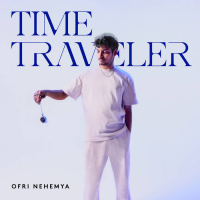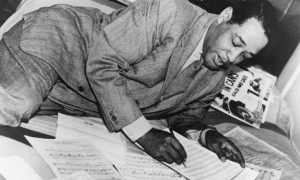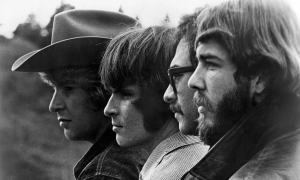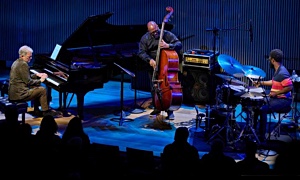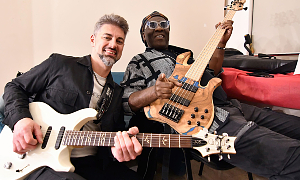Home » Jazz Articles » Interview » Beyond Genre: Brian Marsella’s Expanding Musical Universe
Beyond Genre: Brian Marsella’s Expanding Musical Universe

A prolific contributor to John Zorn's body of work, Marsella has performed on more than 25 albums released on Zorn's Tzadik label. These include Buer: Book of Angels Volume 31 (Tzadik, 2017) Meditations on the Tarot, (Tzadik, 2021) and The Hierophant, (Tzadik, 2019) where his interpretive powers and imaginative range shine through. He is also a key member of Zorn's New Masada Quartet, a group celebrated for reimagining the Masada songbook with intensity, clarity, and freedom.
In this interview, conducted in Skopje during the International Jazz Day celebrations, Marsella spoke about his musical journey, his intuitive approach to collaboration, and the mentors who shaped him—especially Zorn and Brazilian percussionist Cyro Baptista. He reflects on his creative process, how his Italian and Jewish heritage subtly informs his musical voice, and what it means to play with honesty and intention in a world of constant noise.
All About Jazz:Today is International Jazz Day, a moment to celebrate the spirit of the music. As someone who embodies multiple roles in jazz—as a composer, bandleader, and collaborator—how do you personally define jazz, or how would you describe what it means to you?
Brian Marsella: Well, I think for me, if you think of jazz as a genre or a title, that's not very useful. I feel like those names always come after people create music. You know, for me, my music is just a mix—an amalgam—of all the people and musical experiences I've had. And because I've been playing music my whole life, it's taken me to so many different places.
And I love all kinds of music. Fortunately, I've been blessed to meet people who are masters of so many different styles and was able to learn so much from them. I guess the best way to define what jazz is to me is actually the same as any music.
Jazz really is just the ultimate mix of what happens with all the different things you embrace—you ingest, digest—and then jazz is the excretion of that, I guess, in a way. But so many people have so many different thoughts about it.
I don't think too much about definitions. I just think about the music itself and creating the music I want to create.
AAJ:Your performance with the trio resembled an abstract painting coming to life—layered, spontaneous, and full of subtle detail. What, in your view, are the unique strengths of this trio? You have many musical partnerships, but with Kenny and Trevor, the connection felt almost telepathic, like you were painting sound together in real time.
BM: It's very interesting. We were actually talking about this when we got together to rehearse this past week. We were trying out a lot of new music—some that's new for us, some of which we played tonight, and a lot that we'll play throughout the tour.
Part of what I said to them—just like you mentioned—is that I have many different bands and I compose for each of them. The music is very different. A lot of them are larger groups, and I can never tour with them because it's just not feasible to travel with seven, eight, nine, or ten people. That's just not possible for me.
But I've always liked larger groups because with them, you can paint with more colors. And if you have the right musicians, you can play music from all over the world, every kind of genre, even ones that haven't been imagined yet. I never really thought of having a piano trio that could do all of that, maybe because I didn't know the right musicians or think about it in that way.
Kenny and Trevor were unique in my life in that I had known them musically for years without ever having met them in person. When John Zorn asked me to put a trio together to play his Bagatelles, I remember he said, "So who do you want to play with?" We talked about so many possibilities. Then he asked, "What do you think about Kenny and Trevor?" I said, "Man, that'd be incredible. Would they play with me?" And he said, "Of course."
So we started playing. For a long time, we only played John's music. He has a very specific aesthetic—a very particular way he wants his music played and to sound. And because Kenny and Trevor spent so much time in that world, they knew how to approach it. By that point, I had spent enough time in Zorn's world to understand it too.
So we built a chemistry around playing his music. Then we wanted to start touring on our own. But John doesn't like people touring while playing his music. So I thought, "You know what? I'll write music for this trio." The more we played, the more I realized this is a trio that can literally go anywhere.
My dream has always been for each song to feel like its own world. With most jazz trios, even the great ones, they usually have a particular thing they do—whether it's free jazz, straight-ahead, modern jazz with odd meters, whatever their niche is. From the beginning to the end of the set, it stays in that lane. It could be like The Bad Plus, or post-rock, or whatever—but it's that thing.
And I thought: wouldn't it be amazing to do more? With these guys—we didn't do it tonight—but we've learned a ska tune in 3/4, we have some rock-inspired pieces, some exotic stuff coming. The thing with Kenny and Trevor is that they also lived together on the West Coast before moving east, so they have a long shared history. And we're all closely tied with Cyro [Baptista], with John [Zorn]—we've got a lot of strong connections. Trevor and I are playing with Nels [Cline] now, too. So we pull from a lot of places.
But for me, it's like a trip. I grew up in high school being a huge Mr. Bungle fan. So even the first time I met Trevor, I was trying to act very calm, you know?
So to have a trio that I know can do anything—when we want to swing or play changes, we can do that. But we can also go in and out, and we do it so fast, with so much trust. All three of us share this conception of being musical painters. That's what I love. That's why I got into instrumental music. Otherwise, I'd be doing something else.
AAJ:You mentioned John Zorn, whose oeuvre is so vast. Not only have you played on his records, but you've also released many albums on his Tzadik label. Could you talk about your association with Zorn—whether as a composer, bandleader, or instigator of ideas—and how that relationship has shaped or sparked your own projects?
BM: Meeting John, working with him, and becoming friends with him has been a major blessing in my life. I've just grown so much as a musician and artist since I've known him. When John finds musicians he connects with—when he loves their spirit and soul—he keeps creating for them.
In terms of his music, I've now been on close to 25 albums with different bands. First with Kenny and Trevor, then with another trio with Jorge Roeder and Ches Smith, and a quartet with Ches, Jorge, and Julian Lage.Also, a quartet with John Medeski, Matt Hollenberg, and Kenny Grohowski. Through all of those, there have been so many albums.
Each time, he pushes things a little further and wants the band to reach a bit more. I couldn't say enough good things about the experience—it's been incredibly positive. At times, it's overwhelming because as soon as we finish one album, he's writing another one for that project the next week. He just gets so inspired.
So, it's always a lot of music to learn. But yes—it's been a great blessing. I've grown a lot knowing John. He's very gracious, certainly.
AAJ: What are some of your favorite projects that you've done with him?
BM: With John? Listening back now in preparation for this tour—and with some upcoming shows in August, where I have four nights at The Stone playing his music—two with the trio with Ches and Jorge, and two with Trevor and Kenny—I realized how many songs we haven't played in a while. It's been years.
I really love Meditations on the Tarot. That was the last album this trio did of John's music, and I felt there was a lot of great playing on it. I'm also very happy with the albums I did with Ches and Jorge, particularly Suite for Piano. (Tzadik, 2022) That one really marked the beginning of the language for that trio.
We just recorded one called The Book of Impromptus—I don't think it's been released yet, but it will be soon. That one was incredible. It's hard to pick favorites, because normally, whatever the last one is—that's your favorite. And that's what John would say, too.
AAJ:During the piece dedicated to your grandmother, "Częstochowa"—which I believe is a city in Poland—you performed some Jewish melodies. Could you talk about how your heritage influences your music? What elements of that background inspire you and shape your musical identity?
BM: Well, growing up, I always thought—because my grandmother told me—this is my mom's mom—so my mom's side is Jewish, and my dad's side is 100% Italian. So I'm Italian and Jewish. It's a very interesting mix, for sure.
The cultures are quite similar in many ways. My grandmothers were both very similar, each in their own way. Anyway, my mom's mom always told me she was from Częstochowa.
I was playing with another band that recorded music by John, for his label—Zion80, led by Jon Madof—and we were doing a gig at a music festival in Kraków. From the airport, we drove past Częstochowa, and I had this kind of feeling—I started to hear this melody and began thinking of my grandmother. Growing up, I only studied classical piano, and she loved hearing me play classical; Chopin was her favorite.
So I started hearing this melody. It was later, actually, that I found out she wasn't really from Częstochowa—she moved there when she was two. She was born in Kiev. So my grandmother's actually Ukrainian. Yes, she's Ukrainian, but she grew up in Poland before things got too bad there.
And they thankfully emigrated to the United States before the war. So that's kind of where that song came from. It was sort of a mix, because the writing feels like a blend of those roots mixed with a Chopin nocturne, perhaps.
AAJ: You've collaborated extensively with Cyro Baptista, who was also part of John Zorn's world. Could you share more about your projects together? I vividly remember his unique approach to percussion and the incredible soundscapes he creates.
BM: Yes. I met Cyro; I started to play with Beat the Donkey in 2002, which I think was my first time playing.
I met Cyro through a drummer who was one of the percussionists in Beat the Donkey at that point, Tim Kuyper. Tim was a friend—we were in another band, a rock band at the time—so that's how I knew Tim.
And I had seen Beat the Donkey perform a couple of times, and I loved it. I don't know—I wouldn't even call it a band. It was like, what? Is it a stage show? Is it a band? It was like everything: theater, comedy, every kind of music you could imagine.
It was positive energy—it was bizarre, crazy, colorful. I was like, "Wow, this is amazing." I didn't even know I wanted to do this, but that's kind of what I wanted to do.
And I guess you know the multi-instrumentalist Peter Heffelbaum. Peter was playing in Beat the Donkey at that time—he played saxophone, organ, melodica—and when he couldn't do a gig in New York, and Cyro needed a substitute, my friend Tim said, "I think I know somebody who could come in and sub."
And I came in and subbed, without any rehearsal or anything—it was a last-minute thing. I came in, played the show, and at that point, Cyro made me part of the band. And then Cyro became one of my closest friends.
We live—actually, we're neighbors in New Jersey—and he plays in my projects. Obviously, I played in Beat the Donkey and then with Cyro. Around 2006, I started a quartet with Tim, myself, and Shanir Blumengranz.
It was kind of loosely modeled after Don Cherry and Codona—with Nana and Collin Walcott. At first, we were doing a lot of Don Cherry's music and things that Cyro had learned from Nana. And then we kind of developed our own thing and started doing Zorn's stuff too.
So those were the two bands for a while. Then, around 2017, I wanted to write an album of music for Cyro, and that's when I did the album Gatos Do Sul, which John released on Tzadik.
But that was all the music that I wrote specifically for Cyro.
AAJ: What are the things you've learned from all these people we mentioned—and maybe some we didn't mention? What have you incorporated into your own music?
BM: Well, so many. One thing I learned—from both Cyro and Zorn—is that every moment is important; never waste a moment. One of the things that really struck me about Cyro, particularly when I first started playing with Beat the Donkey, was how theatrical and intentional he was with even how he picked up each instrument.
It was all done with artistry—even when he put something down. It was like he always knew the audience was watching everything you did. It's not just the notes you're playing or the rhythms you're doing; it's a lot about stage presence. And from Zorn, I learned not to waste, to be very concise.
I think about how much can be said in a short amount of time. John has a saying—sometimes in one of his pieces, like his cartoon pieces, there might be one measure, four beats; he'll say, "I want the whole history of jazz in those four beats." And we'll do like 20 or 30 takes. Eventually, you get it, and you learn just how much you can say in four beats of F7.
Musicians often allow things to evolve and take their time, and that's beautiful, too. But it was something that I learned with Zorn: things need to happen quickly. Get to what you want to say, say it, and then move on. So that's one thing. But there's so much more.
I've learned a lot about being a human being, about being a band leader—what it means to write and inspire the people around you, to create an environment that is inviting and allows those around you to thrive. That's really important—to create a culture and a space where not only do people want to be, but they are their best selves. And I think both Zorn and Cyril are really good at that: helping us be our best selves.
AAJ: What's next for you?
BM: Well, I just became a dad—my son was born two weeks ago, so I'm right in the middle of the beginning of that experience. My wife, Sai Hashimoto, is a musician too. She plays the vibraphone and is also a classical percussionist. She works with John Zorn as well. During the pandemic, John commissioned a project with her, me, and Ikue Mori to create an album, which was great. There's another one on Sonic called Archipelago X.
Sai and I recently recorded a duo album featuring piano and vibraphone music that we co-wrote, and we hope to perform it soon.
As for what's next musically, I'm not entirely sure. Being a dad will take up a lot of my time, and I want to make space for that. But I do have new music for my band, the Modulators—it's a punk-surf band—and I've got some songs I'd like to sing, possibly collaborating with Petra on something too.
I also just finished the latest Imaginarium album, which is a three-disc set I poured a lot into. It's two and a half hours of music, and it's the fourth chapter of the series. I have ideas for a fifth chapter, which would likely be a piano concerto.
Tags
Interview
Brian Marsella
Nenad Georgievski
Macedonia
Skopje
Trevor Dunn
Kenny Wollesen
john zorn
Julian Lage
Cyro Baptista
Imaginarium
Comments
PREVIOUS / NEXT
Support All About Jazz
 All About Jazz has been a pillar of jazz since 1995, championing it as an art form and, more importantly, supporting the musicians who make it. Our enduring commitment has made "AAJ" one of the most culturally important websites of its kind, read by hundreds of thousands of fans, musicians and industry figures every month.
All About Jazz has been a pillar of jazz since 1995, championing it as an art form and, more importantly, supporting the musicians who make it. Our enduring commitment has made "AAJ" one of the most culturally important websites of its kind, read by hundreds of thousands of fans, musicians and industry figures every month.




